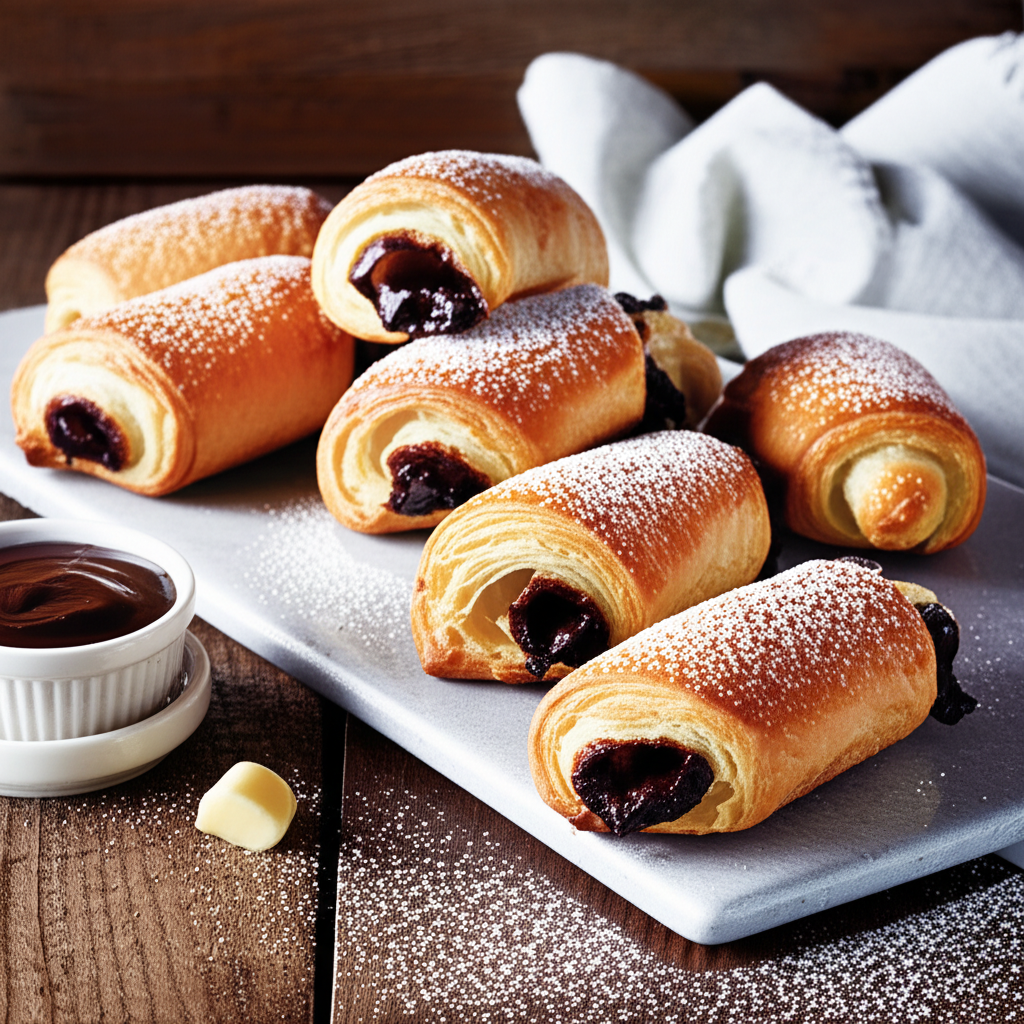Homemade Chocolate Croissants: An Easy & Decadent Recipe
Indulge in the Richness of Homemade Chocolate Croissants
Is there anything more delightful than biting into a warm, flaky chocolate croissant? The crisp, buttery layers giving way to a molten chocolate center is a truly unparalleled experience. While often considered a bakery-exclusive treat, making Chocolate Croissants, or pain au chocolat, at home is surprisingly achievable, even for beginner bakers. This recipe will guide you through each step, from creating the laminated dough to achieving that perfect golden-brown finish.
<p>The chocolate croissant’s origins trace back to the Austrian kipferl, a crescent-shaped pastry. When Austrian bakers brought the kipferl to France, it evolved into the croissant we know and love today. The addition of chocolate, transforming it into pain au chocolat, added another layer of decadence to this already exquisite pastry. The combination of buttery dough and rich chocolate has made it a breakfast staple and a beloved treat worldwide.The flavor profile of a chocolate croissant is a symphony of textures and tastes. The exterior boasts a satisfying crispness that gives way to a soft, airy interior. The buttery, slightly sweet dough complements the intense, bittersweet chocolate filling. The result is a balanced and incredibly satisfying pastry that is perfect for breakfast, brunch, or an afternoon treat.
<h2>Ingredients You’ll Need- For the Dough:
- 3 1/4 cups (400g) all-purpose flour, plus more for dusting
- 1/4 cup (50g) granulated sugar
- 1 teaspoon (5g) salt
- 1/4 ounce (7g) active dry yeast
- 3/4 cup (180ml) lukewarm milk
- 1/4 cup (60ml) lukewarm water
- 4 tablespoons (56g) unsalted butter, melted
- 1 cup (226g) unsalted butter, cold and cut into 1/4-inch thick slices
- For the Filling:
- 4 ounces (113g) bittersweet chocolate, cut into batons or use chocolate chips
- 1 large egg, beaten (for egg wash)
- Keep the butter cold: The key to flaky croissants is keeping the butter cold throughout the lamination process. If the butter starts to melt, the layers will not form properly.
- Work quickly: The warmer the dough, the more difficult it will be to work with. Try to work efficiently to minimize the time the dough spends at room temperature.
- Don’t over-proof: Over-proofed croissants will collapse in the oven. They should be puffy but not overly soft before baking.
- Experiment with fillings: Try different types of chocolate, such as milk chocolate or white chocolate. You can also add nuts, fruit, or pastry cream to the filling.
- Make ahead: The dough can be made ahead of time and stored in the refrigerator for up to 2 days. You can also shape the croissants and freeze them before proofing. When ready to bake, thaw them overnight in the refrigerator and then proof as directed.
Step-by-Step Instructions for Perfect Chocolate Croissants
Step 1: Prepare the Dough
In a large bowl, whisk together the flour, sugar, and salt. In a separate small bowl, dissolve the yeast in the lukewarm milk and water. Let it stand for 5 minutes until foamy.
<p>Add the yeast mixture and melted butter to the dry ingredients. Mix until a shaggy dough forms. Turn the dough out onto a lightly floured surface and knead for 5-7 minutes, or until smooth and elastic. Form the dough into a ball, wrap it in plastic wrap, and refrigerate for at least 2 hours, or preferably overnight.Step 2: Incorporate the Butter
On a lightly floured surface, roll the chilled dough into a 12×18 inch rectangle. Place the cold butter slices evenly over the center two-thirds of the dough. Fold the uncovered third of the dough over the butter, then fold the remaining third over that, creating a three-layer sandwich. Press the edges to seal in the butter.
Step 3: The First Turn
Gently roll the dough into a 12×18 inch rectangle again. Fold it into thirds as before, creating another three-layer sandwich. Wrap the dough in plastic wrap and refrigerate for 30 minutes.
<h3>Step 4: The Second TurnRepeat the rolling and folding process from Step 3. Wrap the dough in plastic wrap and refrigerate for another 30 minutes.
Step 5: The Third Turn
Repeat the rolling and folding process one last time. This completes the lamination process. Wrap the dough in plastic wrap and refrigerate for at least 1 hour, or up to overnight.
Step 6: Shaping the Croissants
On a lightly floured surface, roll the dough into a 12×24 inch rectangle. Use a sharp knife or pizza cutter to trim the edges to create a neat rectangle. Cut the rectangle in half lengthwise, then cut each half into triangles, about 4 inches wide at the base. You should have approximately 12 triangles.
<p>Place a chocolate baton or a small amount of chocolate chips at the base of each triangle. Roll the dough up tightly from the base to the tip. Place the croissants on a baking sheet lined with parchment paper, with the tip tucked underneath.Step 7: Proofing the Croissants
Cover the croissants loosely with plastic wrap and let them proof at room temperature for 1-2 hours, or until they have almost doubled in size. This step is crucial for achieving a light and airy texture.
Step 8: Baking the Croissants
Preheat your oven to 375°F (190°C). Gently brush the croissants with the beaten egg. Bake for 18-22 minutes, or until golden brown and flaky. Let the croissants cool slightly on the baking sheet before transferring them to a wire rack to cool completely (if you can resist eating them warm!).
<h2>Tips and Variations for Perfect ResultsConclusion: The Joy of Homemade Croissants
Making chocolate croissants at home might seem daunting, but with a little patience and practice, you can create bakery-worthy pastries that will impress your family and friends. The satisfaction of biting into a warm, flaky, chocolate-filled croissant that you made yourself is truly rewarding. So, gather your ingredients, follow these steps, and embark on a delicious baking adventure!







